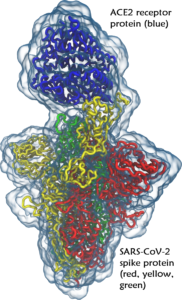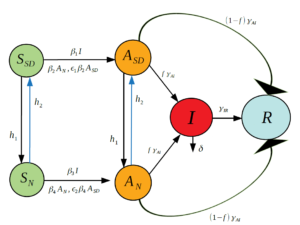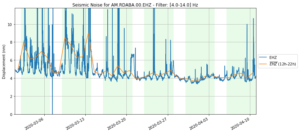Several faculty members from different departments in TCNJ’s School of Science are bringing different disciplinary perspectives to understand a range of effects of the COVID-19 global pandemic.
Computationally Modeling Interactions between the Coronavirus Spike Protein and its Receptor to Understand What Makes this Virus More Efficient in Propagating Disease
Dr. Joseph Baker, Chemistry Department
 Dr. Joseph L. Baker, Associate Professor of Chemistry at TCNJ, is working with an international team of scientists to investigate the interactions between the SARS-CoV-2 spike protein and its receptor in order to better understand what makes this virus more efficient in propagating disease. Dr. Baker is working alongside Dr. Adolfo B. Poma and Dr. Rodrigo A. Moreira at the Institute of Fundamental Technological Research, Polish Academy of Sciences in Warsaw, Poland, and Dr. Horacio V. Guzman at the Jožef Stefan Institute in Ljubljana, Slovenia. The team members are leveraging the power of supercomputing to study this novel coronavirus, and Dr. Baker is carrying out molecular dynamics simulations for this project on TCNJ’s supercomputer ELSA (the Electronic Laboratory for Science and Analysis), which is an NSF-funded cluster housed in the STEM Building on TCNJ’s campus. Ultimately, Dr. Baker’s team hopes that they can learn important information about COVID-19 and about any upcoming emerging diseases in the coronavirus family.
Dr. Joseph L. Baker, Associate Professor of Chemistry at TCNJ, is working with an international team of scientists to investigate the interactions between the SARS-CoV-2 spike protein and its receptor in order to better understand what makes this virus more efficient in propagating disease. Dr. Baker is working alongside Dr. Adolfo B. Poma and Dr. Rodrigo A. Moreira at the Institute of Fundamental Technological Research, Polish Academy of Sciences in Warsaw, Poland, and Dr. Horacio V. Guzman at the Jožef Stefan Institute in Ljubljana, Slovenia. The team members are leveraging the power of supercomputing to study this novel coronavirus, and Dr. Baker is carrying out molecular dynamics simulations for this project on TCNJ’s supercomputer ELSA (the Electronic Laboratory for Science and Analysis), which is an NSF-funded cluster housed in the STEM Building on TCNJ’s campus. Ultimately, Dr. Baker’s team hopes that they can learn important information about COVID-19 and about any upcoming emerging diseases in the coronavirus family.
Mathematically Modeling the Impacts of Social Distancing during the Coronavirus Pandemic
Dr. Jana Gevertz, Mathematics & Statistics Department
 Current COVID-19 policy is being largely influenced by complex mathematical models with parameters, and even choices of variables, that are subject to huge uncertainty. This uncertainty is reflected in the widely diverging predictions reported in the news every day. It is very difficult to understand the sensitivity of outcomes (such as, say, the number of infected individuals over a given period) to model parameters and policy decisions. Moreover, in such complex models it is very difficult to solve “optimal control” problems to guide policy decisions. Dr. Jana Gevertz, Professor of Mathematics at TCNJ, and her team – also consisting of Dr. Eduardo Sontag (Northeastern University), Dr. Cynthia Sanchez (Rutgers University), and Dr. Jim Greene (Clarkson University) – is developing and analyzing a variation of the classic epidemiological SEIR model that incorporates the impact of social distancing. Using their model, they can rigorously formulate and answer questions like: How do we minimize the number of infected individuals over a fixed period of time (“flatten the curve”)? How do we weigh the impact of various types of interventions, including widespread testing, vaccination, or stay-at-home orders? Our hope is that our theoretical framework can provide robust predictions for answering questions such as these so we can best control the spread of the coronavirus.
Current COVID-19 policy is being largely influenced by complex mathematical models with parameters, and even choices of variables, that are subject to huge uncertainty. This uncertainty is reflected in the widely diverging predictions reported in the news every day. It is very difficult to understand the sensitivity of outcomes (such as, say, the number of infected individuals over a given period) to model parameters and policy decisions. Moreover, in such complex models it is very difficult to solve “optimal control” problems to guide policy decisions. Dr. Jana Gevertz, Professor of Mathematics at TCNJ, and her team – also consisting of Dr. Eduardo Sontag (Northeastern University), Dr. Cynthia Sanchez (Rutgers University), and Dr. Jim Greene (Clarkson University) – is developing and analyzing a variation of the classic epidemiological SEIR model that incorporates the impact of social distancing. Using their model, they can rigorously formulate and answer questions like: How do we minimize the number of infected individuals over a fixed period of time (“flatten the curve”)? How do we weigh the impact of various types of interventions, including widespread testing, vaccination, or stay-at-home orders? Our hope is that our theoretical framework can provide robust predictions for answering questions such as these so we can best control the spread of the coronavirus.
- Read the pre-print article from medRxiv here.
Illustrating the Seismic Effects of Coronavirus on the TCNJ Campus
Dr. Shannon Graham, Physics Department
What happens seismically when TCNJ learns and works remotely due to COVID-19? Dr. Shannon Graham, Assistant Professor of Physics at TCNJ, in collaboration with Dr. Alan Kafka of Boston College has observed a dramatic reduction in seismic activity. The image shows the seismic ‘noise’ on campus in blue and the daily average in orange. A clear trend begins on March 14, 2020. An increase in noise around April 10, 2020 is likely due to strong storms and high winds. (Computed with software from Thomas Lecocq @seismotom.)

